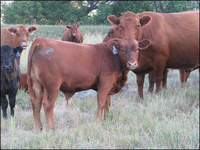NDSU Extension Specialists Say Proper Timing of Livestock Pest Management is Vital
(Click the image below to view a high-resolution image that can be downloaded)
Face flies, horn flies and stable flies are the most common and most treated pests on North Dakota livestock operations. Left untreated, these pests can cause significant loss in production, says Miranda Meehan, North Dakota State University Extension livestock environmental stewardship specialist.
While integrated pest management (IPM) is commonplace for controlling crop pests, similar concepts can apply to controlling livestock pests, Meehan says. The key is using the right type of control at the right time for the right duration to control pests effectively.
Many North Dakota livestock producers apply pest control prior to pasture turnout, which may be optimal for control of some pests but not others.
Horn flies are gray and look like small houseflies, according to Patrick Beauzay, NDSU Extension entomologist and IPM coordinator. Horn flies bite and spend most of their time clustered around the head, shoulders and back of cattle. These blood-sucking flies feed up to 20 to 30 times per day. This constant biting causes cattle pain and stress, and can reduce the cattle’s weight gains by as much as 20 pounds.
“Face flies look like large, dark houseflies,” Beauzay says. “They are nonbiting flies that feed on animal secretions, plant nectar and manure liquids. Face flies may transmit pathogens responsible for infecting the eye and causing keratoconjunctivitis, or pinkeye, in cattle. The life cycle of a face fly is about 21 days. Populations tend to peak in late summer.”
Stable flies are similar in size to houseflies, but have circular markings that distinguish them from horn flies. In addition, these flies bite on the abdomen and legs, feed on blood and are very disruptive to cattle grazing. They breed on organic matter. The only method to control adult populations is weekly application of insecticide sprays.
Beauzay says horn and face flies typically are not present at pasture turnout and do not reach economic thresholds for applying control until midsummer.
When fly counts reach 200 flies per animal, the economic threshold has been reached and animals will have significant weight loss. The economic threshold is the pest density at which producers should take action to manage the pest, he says.
“The first step to determining when to apply control is to properly scout pastures and cattle to determine fly type and fly populations,” Beauzay says. “Horn flies typically rest on cattle throughout the day, whereas face flies land on the face of cattle for a meal and then retreat to nearby structures, such as fences or forage stands.
“Ear tags contain insecticides that are released slowly into the animal’s hair by movement, so ear tags should not be applied until fly populations are nearing the economic thresholds, typically from mid-June to July. Read insecticide labels carefully because recommendations can vary for the number of tags to apply (one or two), age of cattle that can be tagged and chemical class of active ingredient (pyrethroid, organophosphate or a combination).”
Gerald Stokka, Extension veterinarian and livestock stewardship specialist, recommends rotating the class of insecticide each year and removing tags when they no longer provide effective fly control to help prevent flies from becoming resistant to the insecticides.
To achieve proper fly control, apply pour-on insecticides and sprays periodically depending on environmental conditions, such as rainfall, heat and humidity throughout the fly season, Stokka says. Applying these products before pasture turnout likely will not be an effective fly control method. Additionally, all avermectin pour-ons and injectables impact internal parasites and are not labeled for fly control.
Feed additive insecticides can be included in mineral formulations for the cattle. The additives pass through the animals’ digestive system and destroy the developing horn fly maggots in the manure. These additives are effective in killing 80% to 90% of the developing fly larvae in animals that have consumed the product, he says. Offer feed additives at least 30 days prior to fly emergence in late June or early July.
Back rubbers, dusters and other means of delivering insecticides, as well as nonchemical fly traps and natural fly defense mechanisms also are available. As with the other control methods, producers need to watch for economic thresholds and determine what control measure will work best in their operation, Stokka says.
“When applying any type of pest control, be sure to carefully read the label prior to application. Monitor populations to see if the product is achieving the desired level of control. If a product is not effective, the fly population may have developed a resistance to that type of insecticide and another method and/or product should be utilized,” Stokka says.
Pest control can be costly. However, Meehan says producers can reduce costs by following these principles of integrated pest management and applying the appropriate products at the appropriate time for the appropriate control of pest populations.
NDSU Agriculture Communication – May 27, 2019
| Source: | Miranda Meehan, 701-231-7683, miranda.meehan@ndsu.edu |
|---|---|
| Source: | Patrick Beauzay, 701-231-7064, patrick.beauzay@ndsu.edu |
| Source: | Gerald Stokka, 701-231-5082, gerald.stokka@ndsu.edu |
| Editor: | Becky Koch, 701-231-7875, becky.koch@ndsu.edu |


